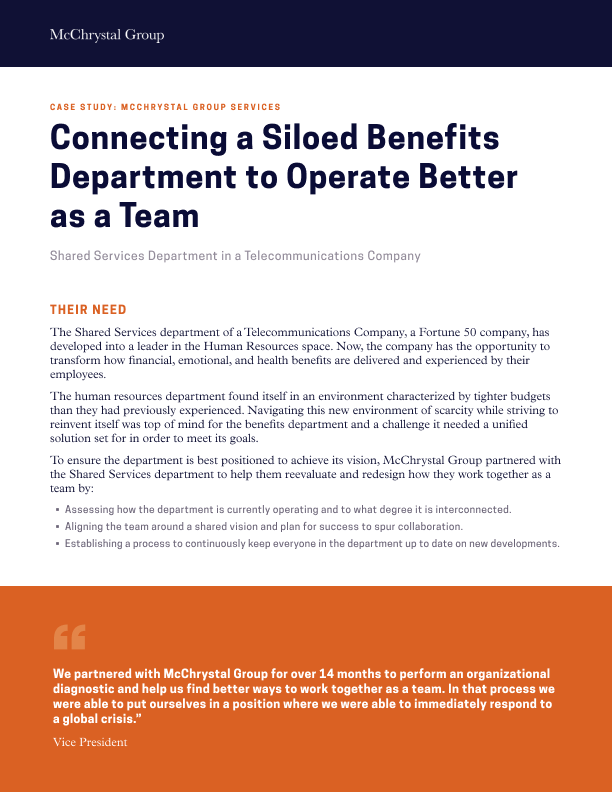The Shared Services department of a Telecommunications Company, a Fortune 50 company, has developed into a leader in the Human Resources space. Now, the company has the opportunity to transform how financial, emotional, and health benefits are delivered and experienced by their employees.
The human resources department found itself in an environment characterized by tighter budgets than they had previously experienced. Navigating this new environment of scarcity while striving to reinvent itself was top of mind for the benefits department and a challenge that required a unified solution set.
To ensure the department is best positioned to achieve its vision, McChrystal Group partnered with the Shared Services department to help them reevaluate and redesign how they work together as a team by:
- Assessing how the department is currently operating and to what degree it is interconnected.
- Aligning the team around a shared vision and plan for success to spur collaboration.
- Establishing a process to continuously keep everyone in the department up to date on new developments.
We partnered with McChrystal Group for over 14 months to perform an organizational diagnostic and help us find better ways to work together as a team. In that process we were able to put ourselves in a position where we were able to immediately respond to a global crisis.”
Vice President
Challenges
Even though the department is unified in both its vision and mission, it is not able to reach its goals because the department lacks a common perspective and coordinated plan and process.
The department articulates the end-state mission but struggles to connect the strategy to this end state. Lack of shared perspective among the senior leadership team (SLT) causes a game of strategy telephone, resulting in a strategy that is interpreted and executed in relative isolation.
- Only 25% of SLT believe that ‘Teams within the department share the same perspective on how to succeed in our industry.’
- Only 31% of individuals believe that ‘Other teams articulate how their actions impact my team.’
The majority of the benefits org operates in silos.
The majority of employees are capable of linking their own goals to their team. However, when we asked how their team’s goals fit within the broader picture and objectives, we saw a large gap resulting in counter-productive work and wasted resources.
- Only 33% of the department believes that internal knowledge is easily accessible to all employees.
- 53% of remote employees mention communication as a top-of-mind challenge.
- Only 51% of directors and above agree that teams within the department collaborate in a way that contributes to the overall success.
SLT members are over-relied on to accomplish goals. Director levels are underleveraged as sources of good information.
The reason why individuals need access to SLT members includes general information and support. This type of information should be able to be passed down through manager and director level executives or exist within the department’s knowledge management. In the current state, SLT members quickly became bottlenecks, slowing down business operations. Opportunity lies in increasing the ability to leverage the rest of the department to function more effectively.
- Only 29% of executive directors believe that ‘decisions are made in time for effective execution’.
Solutions
Conduct department wide assessment of communications and interactions it.
By holding dozens of targeted in-person interviews and observing several meetings to complement our comprehensive diagnostic survey analysis, the department gained an understanding of its challenges in leadership and team integration, alignment on key strategic objectives, and organizational culture.
Leverage the diagnostic insights to inform every step of the way forward.
- Involved mid-level management in a strategy alignment process.
Executive leadership collaborated with their teams to identify key priorities for the department, leading to a holistic view of the department’s key priorities and giving the teams a voice to share their ‘on the ground’ insights rather than focus solely on the SLT’s top level perspective. - Align department leaders around one strategic ‘Plan on a Page’.
We guided the SLT through an alignment exercise taking the priorities suggested by the department and narrowing them down to a final list of key objectives supporting overarching strategies. - Communicate the new unified plan across the whole department.
This allowed a new level of awareness and alignment to be adopted amongst the entire team.
Create a new Operating Rhythm to generate cross-functional awareness, connection, and drive progress on key priorities while holding leaders accountable.
This helped members of the department understand what exactly each team is working on and how they are driving progress on their key objectives.
Impact
Through our partnership, we created a new and sustainable way for the department to work together, resulting in increased inter-connectivity enabling faster and higher quality execution.
The whole department has a clear and united understanding of their strategy and interaction cadences, providing a single source of truth to keep everyone aligned.
As seen in the diagnostic, strategy was interpreted in functional silos and executed vertically in isolation without broader horizontal alignment. With the new process and plan in place that changed.
- “There have been more discussions about [the diagnostic] than any of our internal stuff. It's because of the transparency you pushed and helped with.” —Executive Director
- “Great way to stay connected to the department and the other areas of expertise! After several years with this department I feel like I know what is going on beyond just our specific area.” —Anonymous
- “These (Strategy Forums) have been a huge success in instilling transparency into the group, allowing for better alignment of the overall work, and better development for all willing to participate.” —Senior Vice President
The management team is empowered to own and drive execution, resulting in a more nimble and responsive leadership structure.
- Created four forums for the department to hear about and discuss progress regarding the department’s key objectives to help reinforce a department wide shared consciousness.
- Empowered team members at the mid-management level to now own and drive execution of these key objectives and are involved in shaping future key priorities.
I was shocked at how everything I heard was so relevant and so fundamentally related to our current environment. When I think about the progress this team has made since [starting to work with McChrystal Group] in how we work together—the impact is very clear—it’s like night and day.”
Vice President
Department members better understand what different teams do and how they support their overall vision, resulting in new and better opportunities for collaboration.
Members of the SLT attend purely for awareness to reinforce that the Strategy Forums are led by the facilitators and that the SLT is not expected to play a leading role in this process.
- “Strategy Forums are forcing us to talk to or reach out to people that we otherwise wouldn't have.” —Director
- “Having insight and working knowledge into part of the department that we haven't had before has been quite transformative.” —Supervisor
- “Coming as someone brand new, it's been tremendously helpful for me to learn the language of the department…While the situation is challenging, I think we were kind of set up with the perfect tools (strategy forums) in place.” —Director
The Plan on a Page and Operating Rhythm provide stability and a way to stay connected and aligned during a turbulent crisis, putting the department in the spotlight.
During the Covid-19 crisis, the Benefits department became instrumental in driving the corporation’s medical and safety strategy for responding to the pandemic and keeping their >250,000 employees safe.
- “Strategy Forums have been a godsend through all of this turbulence—the department head leaving, passing, Covid. They'll be a lifeline for everyone going forward in order to stay connected.” —Senior Director
- If the Strategy Forums were not in place, we would have been scrambling to put something like that into place to stay connected [during the pandemic].” —Senior Director
Because of the department’s clear alignment on its strategy, the SLT was able to swiftly adapt and reprioritize the department’s priorities in response to COVID-19, resulting in savings of $25M.
The benefits team is more ready than ever to continue its progress in evolving and bettering how employees experience benefits in the future.
The McChrystal Group team was able to provide organization, structure and really the discipline we needed and did not have before... the results are very apparent and visible. We could not have had a better partner for this.”
Executive Director







